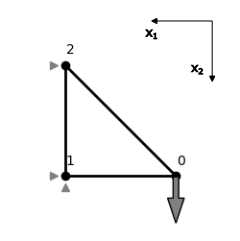Exercise 03 - Constrained optimization¶
We re-use the quadratic function from last exercise $f: \mathcal{R}^2 \rightarrow \mathcal{R}$ defined as
$$ f(\mathbf{x}) = (\mathbf{x} - \tilde{\mathbf{x}}) \cdot \mathbf{Q} \cdot (\mathbf{x} - \tilde{\mathbf{x}}) $$ with $$ \mathbf{Q} = \begin{pmatrix} 2 & 1 \\ 1 & 1 \end{pmatrix} \quad \text{and} \quad \tilde{\mathbf{x}} = \begin{pmatrix} -1\\ 1 \end{pmatrix} $$ to test the implemented gradient decent methods.
from math import sqrt
import matplotlib.pyplot as plt
import torch
from torchfem.utils import plot_contours
torch.set_default_dtype(torch.double)
# Define domain
x1 = torch.linspace(-3, 3, steps=100)
x2 = torch.linspace(-3, 3, steps=100)
x = torch.stack(torch.meshgrid(x1, x2, indexing="xy"), dim=2)
# Define constants
xt = torch.tensor([-1.0, 1.0])
Q = torch.tensor([[2.0, 1.0], [1, 1.0]])
# Define function
def f(x):
dx = x - xt
return torch.einsum("...i,ij,...j", dx, Q, dx)
# Plot function as contour lines
plot_contours(x, f(x), opti=[-1, 1], figsize=(5, 5))
Task 1 - Box constraints¶
We want to solve the problem $$ \min_{\mathbf{x}} \quad f(\mathbf{x})= (\mathbf{x}-\tilde{\mathbf{x}}) \cdot \mathbf{Q} \cdot (\mathbf{x}-\tilde{\mathbf{x}})\\ \textrm{s.t.} \quad \mathbf{x}^- \le \mathbf{x} \le \mathbf{x}^+\\ $$
We have a predefined function named box_constrained_decent(x_init, func, x_lower, x_upper, eta=0.1, maxiter=100) that takes an initial point $\mathbf{x}_0 \in \mathcal{R}^d$ named x_init, a function func, a lower limit $\mathbf{x}^- \in \mathcal{R}^d$ named x_lower, an upper limit $\mathbf{x}^+ \in \mathcal{R}^d$ named x_upper, a step size eta, and an iteration limit max_iter.
a) Implement a simple steepest gradient decent in that function . The function should return a list of all steps $\mathbf{x}_k \in \mathcal{R}^d$ taken during the optimization, i.e. [[x1_0, x2_0, ..., xd_0], [x1_1, x2_1, ..., xd_1], ...]
Hint: Take a look at the function torch.clamp().
def box_constrained_decent(x_init, func, x_lower, x_upper, eta=0.1, max_iter=100):
# Copy initial x to new differentiable tensor x
x = x_init.clone().requires_grad_()
points = [x]
# Implement your solution here
# ...
return points
b) Test the function with the following code for $$ \mathbf{x}_0 = \begin{pmatrix}1\\-1\end{pmatrix} \quad \mathbf{x}^{-} = \begin{pmatrix}0\\-2\end{pmatrix} \quad \mathbf{x}^{+} = \begin{pmatrix}2\\2\end{pmatrix} $$ and play around with the optional parameters.
x_init = torch.tensor([1.0, -1.0])
x_lower = torch.tensor([0.0, -2.0])
x_upper = torch.tensor([2.0, 2.0])
path = box_constrained_decent(x_init, f, x_lower, x_upper)
plot_contours(
x,
f(x),
box=[x_lower, x_upper],
paths={"Box-constrained decent": path},
figsize=(5, 5),
)
print(f"Final values are x_1={path[-1][0]:.3f}, x_2={path[-1][1]:.3f}")
Task 2 - Visualizing Lagrangian duality¶
We consider a function $f: \mathcal{R} \rightarrow \mathcal{R}$ defined as $$ f(x) = x^2$$ for the box-constrained optimization problem $$ \min_{x} f(x) \\ s.t. \quad x \in [1, \infty). $$ We can solve this problem easily by clamping the unconstrained solution $\hat{x}=0$ with the domain as $$ x^* = \textrm{clamp}(\hat{x}, 1, \infty) = 1$$ or using the algorithm from Task 1.
a) Use the algorithm from Task 1 box_constrained_decent to solve this one-dimensional problem.
# Define 'x_init', 'x_lower' and 'x_upper'
# ...
# Define f(x)
# ...
# Solve the optimization and print out the final result
# ...
However, we may also interpret the problem differently considering a function $g: \mathcal{R} \rightarrow \mathcal{R}$ defined as $$ g(x) = 1-x$$ for the constrained optimization problem $$ \min_{x} f(x) \\ s.t. \quad g(x) \le 0. $$
b) Formulate the Lagrangian and plot the Langrangian as function of $x$ and $\mu$. Explain the shape of the plot.
# Define domain
x_s = torch.linspace(-10, 10, steps=100)
mu_s = torch.linspace(-10, 10, steps=100)
x, mu = torch.meshgrid(x_s, mu_s, indexing="xy")
# Define Lagrangian
def L(x, mu):
# Implement the Lagrangian function here
pass
# Plot the Lagrangian
plot_contours(torch.stack([x, mu], dim=2), L(x, mu), colorbar=True, figsize=(5, 5))
plt.xlabel("x")
plt.ylabel("µ")
plt.show()
c) Solve the problem analytically using KKT conditions.
d) Solve the problem using Lagrangian duality and visualize the dual problem in the plot by adding a line $x^*(\mu)$ and plotting the dual objective function. Interpret this line and how it is related to the dual procedure $$\max_{\mu} \min_{x} L(x, \mu)$$
plot_contours(
torch.stack([x, mu], dim=2),
L(x, mu),
opti=[1, 2],
colorbar=True,
figsize=(5, 5),
)
# Add the line plot here
# ...
plt.xlim([-10, 10])
plt.xlabel("x")
plt.ylim([-10, 10])
plt.ylabel("µ")
plt.show()
Task 3 - The first structural optimization problem¶
The three-bar truss illustrated below consists of three bars with the following properties:
- Bar 1 connecting nodes $n^0$ and $n^1$: cross section $A_1$, Young's modulus $E$, length $l$
- Bar 2 connecting nodes $n^1$ and $n^2$: cross section $A_2$, Young's modulus $E$, length $l$
- Bar 3 connecting nodes $n^0$ and $n^2$: cross section $A_3$, Young's modulus $E$, length $\sqrt{2}l$
The truss is subjected to a force $P>0$ at $\mathbf{n}^0$, fixed in $\mathbf{n}^1$ ($u^1_1=0, u^1_2=0$) and simply supported in $\mathbf{n}^2$ ($u^2_1=0$). We want to maximize the stiffness of the truss assembly by minimizing its compliance $P u_2^0$, where $u_2^0$ is the displacement in the vertical $x_2$-direction of node $n_0$. The volume of the trusses may not exceed a volume $V_0$. The design variables are the cross-sectional areas of the bars $\mathbf{x} = \begin{pmatrix} A_1,A_2,A_3\end{pmatrix}^\top$.

Credits: Peter W. Christensen and Anders Klarbring. An Introduction to Structural Optimization. Springer Netherlands, 2008.
a) Formulate the problem as a constrained optimization problem using an explicit expression for $u_2^0$.
b) Solve the problem analytically using KKT conditions.
c) Solve the problem analytically using Lagrangian duality.
d) Define the objective function using $x_1=x_2$ and plot it in the $x_1$-$x_3$ plane as contour plot. Assuming $L=1$ and $V_0=1$, plot the contrained area.